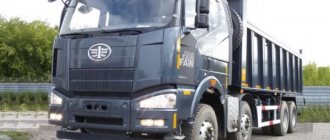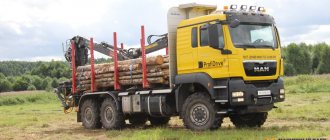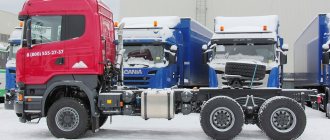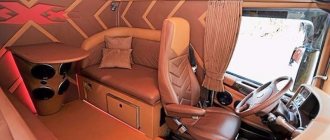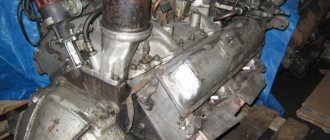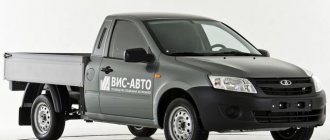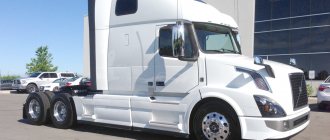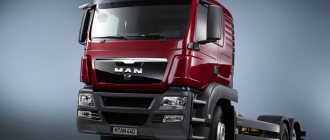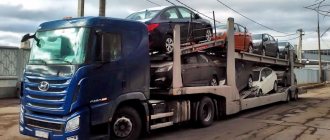About MAN view
| Manufacturer: | MAN Nutzfahrzeuge AG |
| Model: | MAN TGX 18.400 (4x2) BLS |
| Start of sales in Russia: | 2009 |
| Price: | RUB 3,655,000 |
Pavel Gamankov, photo by the author
The MAN TGX truck tractor is positioned as a new generation vehicle, which has become a logical and more modern continuation of the TGA series vehicles. But upon closer examination of the updated “saddle bar”, it became clear that the car is in many ways identical to its predecessor. The suspension, powertrain and other design solutions are noticeably similar to their predecessor cars. But there are also differences. It’s not for nothing that the MAN TGX became the “Best Truck of 2008”.
The most noticeable changes affected the appearance of the car. The front optics have received more aggressive features, the ventilation holes in the front bumper have become noticeably larger, and the radiator grille, on the contrary, is now airtight. To protect the cooling radiator from midges, a removable mosquito grill is provided. Huge rear-view mirrors are “hidden” in single housings, and for ease of maneuvering the car is equipped with front roll-up and side curb mirrors. An interesting feature of the “saddleback” design is that, depending on the color of the cabin, the car can look aggressive (dark blue and black) or cute and cute (light and white tones).
Another noticeable detail is the presence of a spare tire behind the battery box. It seems like nothing special, but modern “saddle bikes” are increasingly equipped with urea tanks, huge barrels of neutralizers or additional fuel tanks. Therefore, there is simply no room left for a spare wheel. In the MAN TGX, the designers managed to retain the additional wheel without prejudice to other “actors”. In our case, the fuel tank volume is 910 liters, despite the fact that the wheelbase houses batteries and a catalyst with a MAN PM KAT particulate filter. A ladder is built into the tank for access to the platform behind the cabin, and the right spoiler covering the handrails moves forward, making access easier. By the way, this solution is very convenient and practical. Competitors have a lot to learn.
Salon of the Year
In order to get into the cabin of the MAN TGX 18.400, you will have to climb four steps and climb to a height of 1510 mm. And the total height of the truck tractor without spoiler is 3420 mm. It is easy to calculate that the distance from floor to ceiling in the cabin is about 1900 mm. This means that a driver of average height will be able to move around the tractor cab without any problems without bending. And this despite the fact that the XLX cabin is not top-end; in the TGX line there are even more spacious XXL cabins.
At first glance, the interior space is somewhat “eaten up” by the protruding tide of the gearbox lever. In fact, moving around the cabin is quite convenient. An insulated food box is hidden under the “sleeping bag”, two garbage bins too, and the motor tunnel protrudes just a few centimeters above the floor level. Therefore, even two drivers in the cabin can feel comfortable.
For greater convenience, access to tool boxes from the interior is provided. It is enough just to raise the lower sleeping bunk. But even here there was a fly in the ointment. This shelf does not lock in the raised position, so getting anything out of the drawer is problematic. Additionally, there are no steps to access the top bunk. And if, having stood in the passenger seat, it is not difficult to climb up, then you can only get down with the help of acrobatic pirouettes. And if during the test of a “Chinese”, MAZ or KamAZ I would not even pay attention to the absence of a ladder, then from a “Big Seven” vehicle (and even more so from the holder of the title “Best Truck of 2008”) you expect a little more.
The front panel has changed significantly compared to the previous generation of TGA machines. There are more pockets, drawers and niches for storing things, and above the engine tunnel there is a wide pull-out shelf for small items. There is even a separate box for storing sunglasses. The instrument cluster has also been modified. Information from the Russified on-board computer is displayed on the LCD screen. The computer controls are located on the steering wheel, but navigation takes some getting used to, since the driver will have to “communicate” with ten (!!!) keys, which is somewhat puzzling at first. The readings of other instruments are perfectly readable; the scales are illuminated in any mode, even with the headlights off.
The range of adjustments for the driver's seat with air suspension can serve as an example for many competitors. But adjusting the steering wheel may cause some complaints for a picky user. The range of reach of the steering column is clearly insufficient; you constantly want to pull the steering wheel a little higher, but this is impossible to do; you have to lower the seat cushion down, which may not please both tall and short “drivers.” Armrests on both sides of the driver's seat are installed rather for show in the equipment list. They do not create any interference when driving, but they do not add comfort while driving. Unless at steady speeds you can lean on one of them, but holding the steering wheel with both hands is inconvenient. But visibility from the driver's seat is excellent in any seat position. A large glass area and perfectly configured garlands of mirrors make it easy to control the dimensions of the road train. If we were to add an additional spherical mirror on the driver's side, the visibility to the rear could be called absolutely ideal.
The geometric dimensions of the sleeping shelves cannot be called outstanding. The width of the lower shelf is 790 mm, the upper one is 700 mm, the length is 2200 and 2125 mm, respectively. Not much and not little, but in fact, “sleeping bags” are comfortable and practical. This is confirmed both by my subjective opinion and by the stories of truckers working on TGX machines. In addition, do not forget that we tested a tractor with a budget (if such a word can be applied to expensive MAN Nutzfahrzeuge tractors) cab for long-haul transportation.
Two from the designer
The Manovites call the technology for building their trucks “Baukasten”, “a box of cubes”: if you assemble it this way, you’ll get one model, otherwise you’ll get another. Here it is: the chassis is exactly the same, but the engines and cabs are different.
The XXL cabin is wide and high, the LX is twenty centimeters narrower and almost half a meter lower. The short instructor Manfred stands at full height on the engine tunnel, but I already have to bend down. Yes, and there is a difference in the size of the beds, although not very big.
Radio and navigation controls (to the right of the steering wheel) are in plain sight. But the block that combines control of climate control and various systems (bottom right) is hard to see while driving
Now we throw back the “heads”. When I said that a few days ago I drove a KAMAZ, which requires 135 lever strokes to raise the cab, and 216 lever strokes to lower it, Manfred just laughed. For him this is exotic...
You crouch at the right step, press a rubberized button, and the electric motor, whirring, tilts the cabin in just over a minute. But there is also a regular hydraulic pump: the lever for it is stored under the front trim, and above it is a sliding mop handle for cleaning glass and scraping off ice. I would advise all truck manufacturers to adopt this solution!
The interior of the XXL and LX cabins differs in length and number of drawers below (two or one)
0 / 0
The engines, despite the difference in displacement, are indistinguishable in appearance: on the right is a compact turbocharger, on the left are electronic “brains” and a common rail injection ramp. Despite the fact that the oil level is shown on the display, there is an oil dipstick, and that’s right: when you see the level with your own eyes, it’s somehow calmer. I ask carriers who are accustomed to good technology not to be sarcastic!
Other design elements are completely identical: the frames are the same, the axles are the same (with the exception of gear ratios), the gearboxes are automated ZF AS-Tronic (according to the Manov classification - TipMatic). But why don’t any of the tractors have my favorite transmission brake-retarder? It is clear that you have to pay more than 6,000 euros for it, but did the Germans really spare money on demo copies?
The “small” cabin (right) is almost half a meter lower: drivers taller than average will have to bend down
In the “small” cabin the beds are a little shorter and narrower, but this is not critical
0 / 0
“I didn’t guess,” Manfred shakes his head. “If there is a retarder, even if it is not turned on, fuel consumption automatically increases by half a liter per hundred kilometers.” Now it’s clear - as well as why both tractors have Michelin Energy tires with reduced rolling resistance, aluminum wheels (forged, by the way, 3890 euros for seven pieces), a set of fairings (more than three thousand euros) and the entire bottom of the semi-trailers is closed aerodynamic flaps.
By the way, speaking of savings: these examples had a Profi gearbox, but you can also order the Fleet option - for large fleets, without kick-down. There is no need for hired drivers to put too much pressure on the car in vain!
Slow but powerful
A truck from the series of so-called “ready-made solutions” from MAN came to us for testing, when the buyer is offered an optimized set of options for comfortable operation of the vehicle in Russia and Eastern European countries. To reduce the cost, the “saddleback” is equipped with far from the most powerful power unit among the Euro 4 environmental standard engines presented in the line. The six-cylinder diesel engine D2066 LF32 with a volume of 10.5 liters develops a power of 400 hp. Maximum torque – 1900 N.m. With such indicators, acceleration of a loaded road train cannot be called outstanding. A machine with 20 tons of ballast in a semi-trailer slowly picks up speed. When starting from a standstill, the tractor will cover 1000 m in just over 75 seconds. But the power unit has traction. A loaded road train climbs a hill confidently, practically without losing speed, which is even more important for a “saddle rider” than dynamic acceleration.
The shift pattern of the 8-speed ZF 16 S 222 DD gearbox is simple, so working with the gearbox is not difficult. Start at second speed, third and fourth gears are used only at low speeds up to 30–40 km/h. Next, the range multiplier is moved to the upper position and the car begins to accelerate. Everything is extremely simple, clear and convenient. The only drawback is the slow operation of the electronics. More precisely, a display that displays information about the position of the range multiplier, the currently engaged gear, etc. When shifting the gearbox to the upper speed range, the display immediately suggests engaging VI gear, while it is appropriate to “push” only V. I even doubted my own knowledge several times and tried to follow the instructions of the “electronic mind,” but practice said otherwise.
The vibrations of the diesel power unit are practically not transmitted to the steering wheel and other controls. We also liked the noise insulation of the cabin; at a maximum speed of 88 km/h (the limiter does not allow moving at higher speeds), there is practically no aerodynamic noise in the cabin. Subsequently, our guesses were confirmed by specific figures - in comparison with TGA machines, aerodynamic drag was reduced by 4%, and the noise level during movement was reduced by almost 30%.
The front double-leaf spring suspension in combination with the four-point air suspension of the cab and the sprung seat provides excellent ride comfort from the driver's point of view. The passenger is not so comfortable, but he also does not feel like a poor relative. The suspension “eats up” the lion's share of uneven road surfaces. This statement is also true for an empty road train. At the rear, the designers used air suspension, which, although not very practical when using a “saddle bar” in Russia, is convenient.
Separately, we note the engine retarder, which turned out to be very effective. In some driving modes, it turns on automatically, simultaneously with pressing the brake pedal. When descending a mountain, the engine brake can be applied forcefully, thus relieving the expensive front and rear disc brakes of the load.
Everything at the service station
To access the power unit and gearbox, you need to raise the cab. And here, since the founding of Rome, nothing has changed. Lifting is carried out manually, using a pump located on the right, between the first and second steps. We take the wheel wrench, insert the adapter into it, and into the last one - the assembly. And go ahead - let's start the morning warm-up. In addition, when tilting the cab, it is imperative to open the front radiator grille, otherwise it can be damaged. Frankly, not the best solution for a royal-class car produced in the 21st century. The only justification can be the fact that MAN TGX drivers will not have to do such morning warm-ups often. After all, the quality and reliability of German components is beyond doubt. But the fact remains that Asian manufacturers have long realized that installing electric lifting pumps on cars is inexpensive and practical. Europeans remain conservative on this issue.
If it is necessary to carry out more or less major repairs, you will have to remove the side noise-insulating sides covering the engine. Otherwise, it is difficult to approach the power unit. Without dismantling the protection, you can only check the oil level in the engine, and even reach the manual fuel pump. By the way, the presence of such a “device” on a Euro 4 engine is quite appropriate when operating a car in Russia. Personally, the manual fuel pump has helped me start the engine more than once in severe frosts. And there is plenty of this “good” in our country.
Replacing basic consumables is easy. The filters are located in accessible places, and the electronics will notify you of the need for replacement. The air filter is hidden next to the engine, so changing it requires tilting the cab. Not the best solution, but apparently there was no other place. As we have already said, the wheelbase is filled with such things as a fuel tank, a catalyst, a spare wheel and a battery box.
Technical characteristics of MAN TGX 18.400 4x2 BLS type 06XD257
| Gross vehicle weight, kg | 18 000 |
| Gross weight of the road train, kg | 40 000 |
| Wheel formula | 4x2 |
Engine:
| MAN D2066LF32 10 500 400 at 1900 min-1 1900 at 1400 min-1 |
Transmission:
| ZF 16 S 222 DD, mechanical 16/2 |
| Suspension front/rear | Spring/pneumatic |
| Brake system | Pneumatic, disc |
| Tires | 315/70 R22.5 |
| Fuel tank capacity, l | 910 |
The tools included with the car, with the exception of the usual jack and a set of keys, also include such things as a scraper for cleaning the car from snow and ice, a brush for washing glass with a telescopic handle. So now the driver does not have to climb onto the bumper to clean the windshield. Reasonable and practical. It’s surprising that all truck manufacturers have not yet come to this decision.
Separately it is possible about those included in the MAN TGX 18.400 package. For example, a car has an option such as automatic lubrication of the fifth wheel coupling. Just press a button on the front panel, and lubricant is supplied to the “seat” through special pipes. Another function to help the driver is checking the lighting equipment. It would seem like a trifle, but checking every light bulb (and on a modern road train there are at least two dozen of them) can sometimes be problematic. It is even more difficult to check, for example, brake lights if the driver is alone on the trip. And when electronics are responsible for this, it’s much more fun.
A car for the soul
The work of a journalist and tester requires one to operate only with facts and rely on specific arguments and figures. But in the case of the MAN TGX 18.400 truck tractor, I will allow myself to move away from these postulates and look at the German-Polish car from the point of view of a simple driver who will have to work on the MAN TGX truck. And if we talk about subjective sensations, the car evokes only positive emotions. Even the insufficient engine power and some problems with gear shifting do not spoil the overall impression. The car turned out to be very balanced both in terms of technical indicators and in terms of configuration. And even despite the small number of differences between this tractor and the TGA series vehicles, it is the TGX line that should be recognized as worthy of the title “Best Truck of the Year.”
The test vehicle was provided by MAN Automobiles Russia LLC
Used and new MAN tractors
In addition to the website, available models with prices can be viewed in our Avito online store and Instagram group.
"Company STT-Auto" offers to choose and buy a used and new MAN tractor from a wide range of trucks presented on our site. We sell imported models of various load capacities and years of manufacture, adapted for use in Russia, such as DAF, Volvo, Scania, Mercedes, as well as trucks and semi-trailers for various purposes.
Trucks produced under this brand are an excellent solution for short and long distance transportation. They are characterized by high build quality, the use of innovative technologies and excellent design. The trucks we offer will be a decoration for any fleet. In our catalog you can choose both new and used freight vehicles.
At parking lots in the village of Durykino and the village. In Dolmatovo, you can purchase MAN TGH, TGA tractors without mileage in the Russian Federation from Europe.
